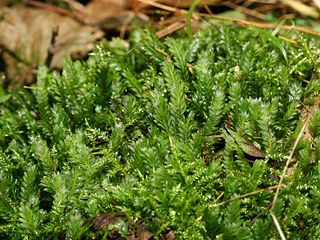
Fissidens adianthoides, the maidenhair pocketmoss, is a moss in the family Fissidentaceae. It was first collected by Hedwig in 1801.
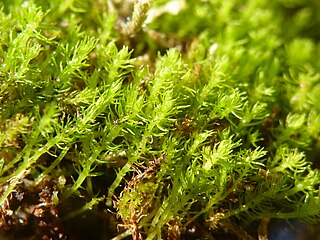
Takakia is a genus of two species of mosses known from western North America and central and eastern Asia. The genus is placed as a separate family, order and class among the mosses. It has had a history of uncertain placement, but the discovery of sporophytes clearly of the moss-type firmly supports placement with the mosses.
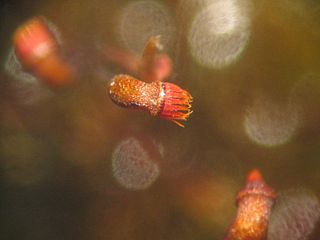
The Bryopsida constitute the largest class of mosses, containing 95% of all moss species. It consists of approximately 11,500 species, common throughout the whole world.

Polytrichum commune is a species of moss found in many regions with high humidity and rainfall. The species can be exceptionally tall for a moss with stems often exceeding 30 cm (12 in) and rarely reaching 70 cm (27.5 in), but it is most commonly found at shorter lengths of 5 to 10 cm. It is widely distributed throughout temperate and boreal latitudes in the Northern Hemisphere and also found in Mexico, several Pacific Islands including New Zealand, and also in Australia. It typically grows in bogs, wet heathland and along forest streams. Additionally, class Polytrichopsida has been shown to thrive in partially open habitats that have been recently disturbed by human activities or even livestock.

Neckeraceae is a moss family in the order Hypnales. There are about 200 species native to temperate and tropical regions. Most grow on rocks, or other plants.

Riella is a genus in the liverwort family Riellaceae, and includes about eighteen species. Plants in the genus are small and grow submerged in shallow temporary pools. Although the genus is widely distributed in the Northern Hemisphere, locating populations is often difficult. Its occurrence is sporadic and local, and the tiny plants are ephemeral. The ornamented spores remain viable for several years, allowing the plants to survive annual drying of their habitat. The plants are easily grown in laboratory cultures.

The Pottiaceae are a family of mosses. They form the most numerous moss family known, containing nearly 1500 species or more than 10% of the 10,000 to 15,000 moss species known.

Polytrichastrum alpinum, also known as Alpine haircap, is a species of moss from the family Polytrichaceae. It is widely distributed and may be found growing among other moss species.
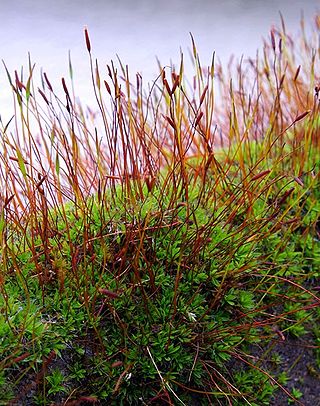
Tortula is a genus of mosses in the family Pottiaceae.
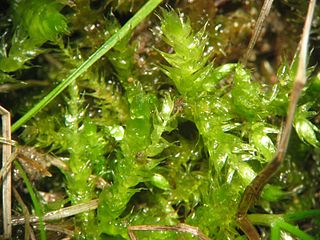
Brachytheciaceae is a family of mosses from the order Hypnales. The family includes over 40 genera and 250 species.
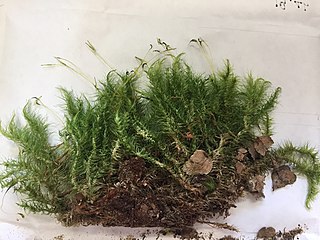
Dicranoloma dicarpum is relatively common moss which is widespread in the Southern Hemisphere. The genus Dicranoloma has 40 species, which share the features of long stems, wispy and twisted leaves, and large, erect capsules. The genus is dominant in wet forest habitats in Australia and New Zealand.

Fissidens limbatus commonly known as Herzog's pocket-moss, is a moss in the family Fissidentaceae. This species is found growing in high elevations in tropical America in addition to the US, Mexico and Canada. Montagne first collected F. crispus in 1838.
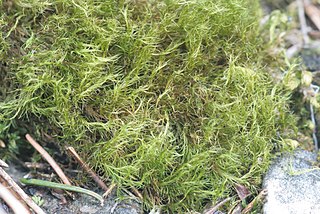
Flexitrichum is a genus of haplolepideous mosses (Dicranidae) in the family Flexitrichaceae.

Tortula muralis, commonly known as wall-screw moss, is a species of moss in the family Pottiaceae. T. muralis is found throughout the world.
Timmiellaceae is a family of haplolepideous mosses (Dicranidae). It contains two genera, Luisierella and Timmiella, that were formerly place in family Pottiaceae.
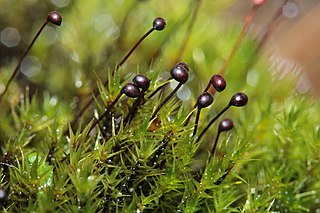
Catoscopium is a genus of haplolepidous mosses (Dicranidae) in the monotypic family Catoscopiaceae .

Rhynchostegium is a genus of pleurocarpous mosses belonging to the family Brachytheciaceae. The genus has a cosmopolitan distribution across different climatological regions except the polar regions, mostly in tropic to north temperate regions. The genus contains both aquatic and terrestrial species. The genus was named for their rostrate opercula. The type species of this genus is Rhynchostegium confertum (Dicks.) Schimp.

Polytrichastrum formosum, commonly known as the bank haircap moss, is a species of moss belonging to the family Polytrichaceae.
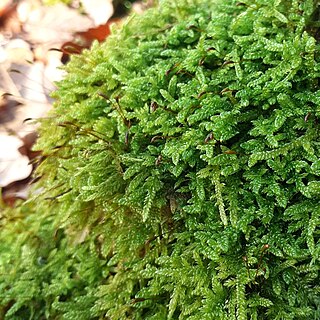
Hypnum is a genus of mosses belonging to the family Hypnaceae.

Arctoa pumila is a species of moss in the family Dicranaceae. It is recorded in New Zealand, and Tasmania and Victoria in Australia. Forming tufts, it grows in alpine and sub-alpine environments. The moss Kiaeria pumila (Mitt.) Ochyra was transferred to the genus Arctoa in 2021 creating the name Arctoa pumila.



















